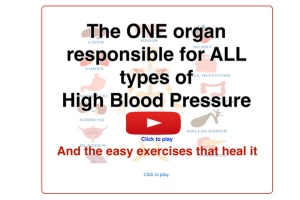Blood pressure in an artery is similar to water pressure in a hose. It is measured by the amount of weight necessary to stop the flow by squeezing the artery shut, exactly like stepping on a hose to shut off the water.
An understanding of blood pressure is basically simple. It is the pressure from the heart necessary to drive blood through our blood vessels, and it varies with conditions such as work or rest. We recognize a high and low pressure of a wave corresponding to each heartbeat, and we determine what is normal pressure from the average of many thousands of people.


Experience teaches us that blood pressure much higher than normal frequently results in a limitation of body activity through easy fatigue, poor endurance, and lack of a healthy reserve. There are, of course, many other difficulties resulting from high blood pressure, including headache, dizziness, shortness of breath, palpitation, and kidney disease. Also, in the background of high blood pressure disease, hover the specters of stroke and heart failure.

The size of the heart and large arteries may be greatly enlarged with high blood pressure. The normal heart weight of 300 grams can enlarge to 1000 grams. When pressure rises too high, some arteries may burst, and in the brain, this is called a stroke. Nearly half of all definite stroke victims die within two weeks.
The cause of elevated blood pressure for about one-fifth of all cases is from known disease such as arteriosclerosis, adrenal gland difficulty, and thyroid disease. Most high blood pressure, however, is called essential hypertension because the cause is yet to be discovered.

The evidence points heavily to salt as an important factor in high blood pressure. Although its exact role is unknown, the hypersensitive patient often does much better when salt is cut down in the diet.
The treatment of high blood pressure consists principally in the physician’s guidance in diet restriction, weight determination, drug therapy, and continual observation. In no other medical disease is the close cooperation between doctor and patient so richly rewarded as in the treatment of high blood pressure. Like the fitting of shoes, the physician must guide the blood pressure patient into a practical, effective, and tolerable manner of treatment, which the patient will accept and carry on from day to day for complete control of this most significant disease.
So, high blood pressure can lead to serious health problems such as stroke and heart failure. Although the exact cause of essential hypertension is yet to be discovered, evidence suggests that salt plays an important role. Treatment involves a combination of diet, weight management, drug therapy, and ongoing observation with close cooperation between the doctor and patient. By following a practical, effective, and tolerable treatment plan, individuals with high blood pressure can achieve complete control of this significant disease.
